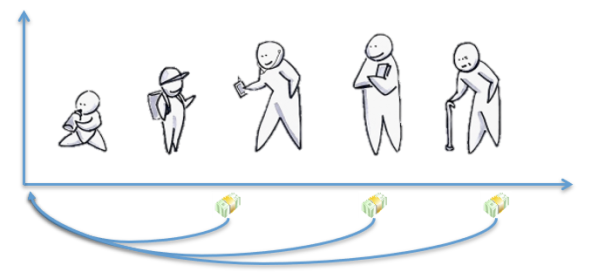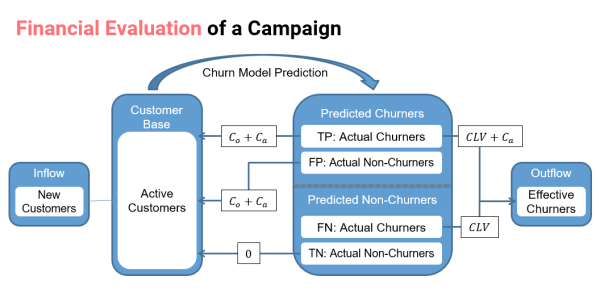By Alejandro Correa and Maria Fernanda Cortes This post is part of a series in which I’m discussing several parts of my AI_at_Rappi presentation. In a previous post I discussed a particular algorithm for recommending restaurants called rest2vec, In a follow-up, I discussed how to include financial costs when analyzing a churn model. This time... Continue Reading →
Maximizing a churn campaign’s profitability with cost-sensitive Machine Learning, part 3
This post is part of a series in which I'm discussing several parts of my AI_at_Rappi presentation. In the last two posts, we first discussed how to evaluate a churn marketing campaign using a financial evaluation measure and then how to estimate the customer lifetime value and also how it is possible to design experiments... Continue Reading →
Maximizing a churn campaign’s profitability with cost-sensitive Machine Learning, part 2
This post is part of a series in which I'm discussing several parts of my AI_at_Rappi presentation. In the latest post, we discussed how to evaluate a churn marketing campaign using a financial evaluation measure. In this one, we're going to deep down in a couple of important concepts needed to fully being able to... Continue Reading →
Maximizing a churn campaign’s profitability with cost-sensitive Machine Learning, part 1.
This post is part of a series in which I'm discussing several parts of my AI_at_Rappi presentation. In a previous post I discussed a particular algorithm for recommending restaurants called rest2vec. This time I wanted to talk about how to model customer churn using cost-sensitive machine learning. Churn modeling The two main objectives of subscription-based... Continue Reading →
Rest2Vec: Recommending similar restaurants
It has been almost a year since I joined the Rappi Artificial Intelligence team. It has been a blast, lots of highly complex challenges with big rewards. As part of my role, I have been giving talks on countless occasions, and even if I have to adjust my speech according to each audience background, I... Continue Reading →
Machine Learning Algorithms Explained – Support Vector Machines
SVMs are some of the most important and widely used algorithms available today. They’re used for supervised classification problems. As a reminder, supervised learning refers to algorithms that learn from training data comprised of both input vectors and expected output data. Classification is used to describe a dataset that the algorithm must separate into predicted... Continue Reading →
How to download Kaggle data into Google Colab
Colab is this awesome initiative from google research that allows anyone to play with Nvidia Telsa K80 for free. I was always struggling on how to show the potential of deep learning to my students without using GPU's. Then everything changed when I discovered colab. To get started in colab (I will write a more... Continue Reading →
Machine Learning Algorithms Explained – Logistic Regression
Logistic regression is a supervised statistical model that predicts outcomes using categorical, dependent variables. Categorical variables take on values that are names or labels, such as: win/lose, healthy/sick or pass/fail. The model can also be used on dependent variables with more than two categories, in which case it is called multinomial logistic regression. Logistic regression... Continue Reading →
Building AI Applications Using Deep Learning
Recently, we have seen a huge boom around the field of deep learning; it is currently being implemented in a wide variety of fields, from driverless cars to product recommendation. In their most primitive form, deep learning algorithms originated in the 1960s. If the concept has been around for decades, why is it that widespread... Continue Reading →
TDWI: 5 Minutes with a Data Scientist: Alejandro Correa Bahnsen of Easy Solutions Lead data scientist Alejandro Correa Bahnsen develops machine learning algorithms for fraud detection. He described for Upside the basic skills and personality traits he believes are necessary to succeed in data science. [Read More]
Applying Data Science to Fraud Prevention
Eighty thousand Kindle users. Sixty-five million Tumblr users. What do they have in common? Both groups had their login credentials breached, courtesy of hackers. While these attacks didn’t directly target financial accounts,the information contained in these breaches is likely being sold on the Dark Web and being used to build a larger profile that will... Continue Reading →
Feature Engineering for Fraud Detection Models
As cybercriminals are constantly updating their strategies to avoid being detected, traditional fraud detection tools, such as expert rules, are less effective as they do not incorporate recent fraud patterns as fast as the fraudsters are changing their behavior. To incorporate the fraudulent behavior fast, it is important to use advanced machine learning algorithms, such as... Continue Reading →










